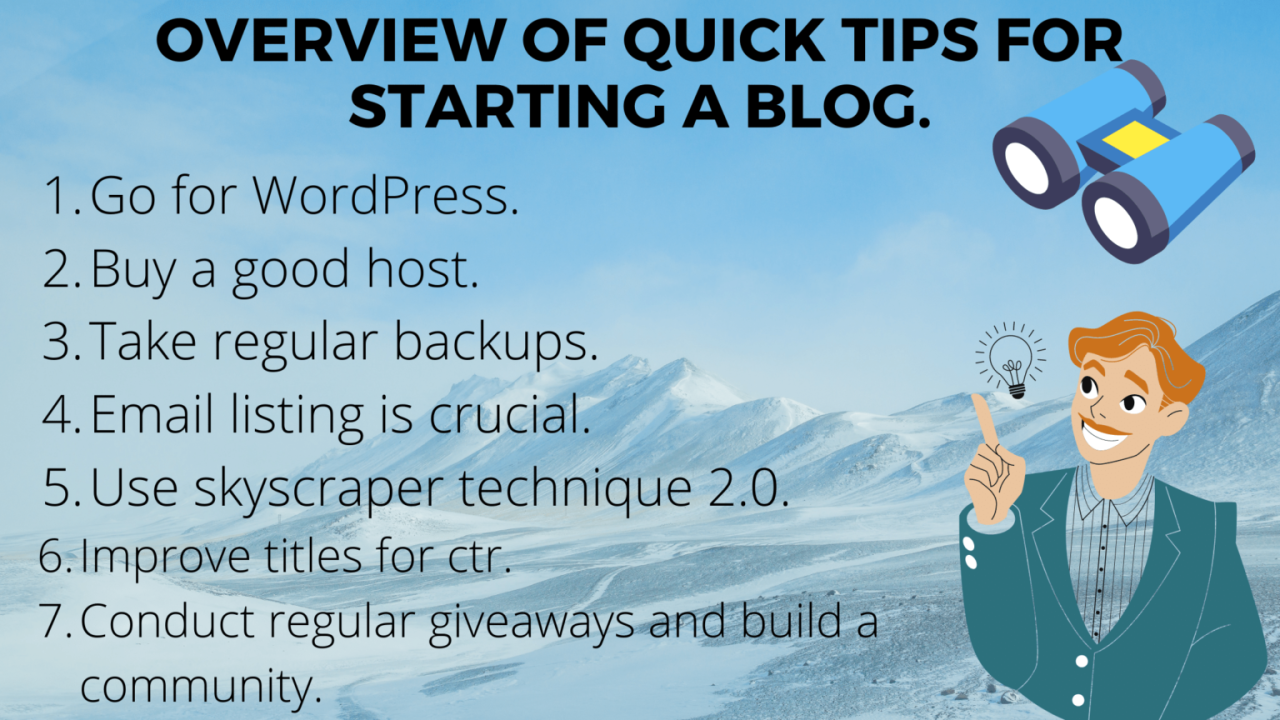
3 Common Myths About Business Blogging
3 Common Myths About Business Blogging: So you’ve heard the whispers – blogging is just self-promotion, it’s a huge time suck, and it’s impossible to measure results. Let’s tackle these common misconceptions head-on and uncover the truth about how a well-executed blog strategy can transform your business. I’m here to debunk those myths and show you how blogging can be a powerful tool for growth, engagement, and building a loyal customer base.
This post will dive deep into each myth, offering practical strategies and real-world examples to prove that blogging can be efficient, effective, and even enjoyable. Get ready to ditch the outdated beliefs and embrace the potential of business blogging!
Blogging is Only for Self-Promotion

Source: entrepreneurshipera.com
Many businesses mistakenly believe that the primary purpose of a blog is to directly sell their products or services. This couldn’t be further from the truth. While promoting your offerings is certainly a benefit, a successful business blog focuses far more on building relationships with customers and establishing itself as a trusted authority in its industry. By providing valuable content, you cultivate loyalty and attract potential clients organically.Businesses can leverage blogging to nurture relationships with customers by offering insightful information, answering common questions, and engaging in meaningful conversations.
This approach fosters a sense of community and trust, making customers more likely to choose your business over competitors. Instead of bombarding them with sales pitches, you’re providing genuine value, solidifying your position as a helpful resource.
Examples of Value-Driven Blog Posts
Providing value to your readers is key to building a strong, engaged audience. Here are some examples of blog posts that prioritize reader benefit over direct sales:* “5 Tips for Choosing the Right [Product Category] for Your Needs”: This post focuses on educating readers about a particular product category, without explicitly mentioning your brand’s specific offerings. It establishes you as an expert and helps readers solve a problem.
The implicit benefit is that when they are ready to buy, your brand will likely be top-of-mind.
“The Ultimate Guide to [Industry-Related Topic]”
This comprehensive guide provides in-depth information on a relevant topic, showcasing your knowledge and expertise. It positions your business as a leader in the field and attracts readers seeking authoritative information. The reader gets valuable information, and your business gets increased brand recognition.
“Case Study
How [Client] Achieved [Result] Using [Your Solution]”: This post showcases the positive impact of your product or service through a real-world example. While subtly promotional, the focus remains on the client’s success, demonstrating the value proposition in a compelling way. The reader gains insight and learns about the practical benefits of your offerings.
Strategies for Fostering Community and Engagement
Creating a thriving blog community requires more than just publishing high-quality content. You need to actively engage with your audience.To foster community and engagement, consider implementing these strategies:* Respond to comments and questions promptly and thoughtfully. Show readers that you value their input and are actively listening.
- Ask open-ended questions at the end of your posts to encourage discussion. This invites readers to share their thoughts and experiences, creating a two-way conversation.
- Run contests and giveaways to incentivize participation and build excitement. These activities can significantly increase engagement and attract new followers.
- Use social media to promote your blog posts and engage with readers on other platforms. This expands your reach and encourages cross-platform interaction.
- Create a space for readers to connect with each other, such as a Facebook group or forum. This fosters a sense of community beyond your blog.
Comparison of Self-Promotional vs. Value-Driven Blog Posts
| Self-Promotional Blog Post | Value-Driven Blog Post |
|---|---|
| Focuses primarily on selling products or services. | Focuses on providing valuable information and insights to the reader. |
| Uses strong sales language and calls to action. | Uses informative and engaging language, with subtle calls to action. |
| May feel pushy or manipulative. | Feels helpful and trustworthy. |
| Often lacks depth and substance. | Offers in-depth information and expertise. |
| Builds short-term gains, but may alienate readers. | Builds long-term relationships and brand loyalty. |
Blogging is too time-consuming

Source: blogspot.com
Many business owners believe that maintaining a consistent blog is a monumental task, requiring hours of daily effort. This perception often prevents them from leveraging the powerful marketing tool that blogging truly is. However, with strategic planning and efficient techniques, blogging can be integrated seamlessly into even the busiest schedules. The key lies in optimizing your workflow and utilizing available resources effectively.
Efficient Content Creation Strategies for Busy Business Owners
Creating high-quality blog content doesn’t necessitate spending countless hours hunched over a keyboard. Instead, focus on streamlined strategies. Batching similar tasks—like brainstorming, writing, and editing—significantly reduces context switching and improves overall efficiency. For instance, dedicate a specific block of time each week solely to content creation. This focused approach allows for deeper concentration and minimizes distractions, leading to faster, more effective output.
Another crucial aspect is to establish a clear content calendar. Planning your topics in advance ensures you’re always prepared and prevents last-minute scrambles for ideas. Prioritize quality over quantity; a single well-written, insightful post is far more valuable than several hastily produced, low-quality pieces.
Benefits of Using Content Scheduling Tools
Content scheduling tools are invaluable for busy business owners. These platforms allow you to write and schedule blog posts in advance, ensuring a consistent flow of content without requiring daily input. Tools like Hootsuite, Buffer, or CoSchedule offer features that automate the posting process, freeing up your time for other crucial business tasks. For example, you can schedule a month’s worth of posts in a single session, ensuring consistent engagement with your audience without the need for daily logins.
This pre-planning also facilitates better content strategy implementation, as you can analyze your planned content’s alignment with your overall marketing goals.
Repurposing Existing Content into Blog Posts, 3 common myths about business blogging
Don’t reinvent the wheel. Repurposing existing content is a highly effective time-saving strategy. Transform presentations, webinars, or even social media threads into blog posts. A webinar transcript can easily be edited and expanded into a comprehensive blog post. Similarly, a successful presentation can be adapted into a series of shorter, focused blog posts, each addressing a specific point.
This reduces the effort needed to create entirely new content, while still providing fresh material for your audience. Consider using existing customer testimonials as inspiration for blog posts addressing common customer concerns or showcasing your product’s impact.
Time-Saving Techniques for Blog Management
Effective blog management hinges on streamlining various processes. Here are some time-saving techniques:
- Use templates: Create pre-designed templates for your blog posts, ensuring consistency in formatting and structure. This eliminates the need to format each post from scratch.
- Outsource tasks: Delegate tasks such as proofreading, image editing, or even content writing to freelancers or virtual assistants. This frees up your time for strategic tasks.
- Utilize research tools: Tools like SEMrush or Ahrefs can identify relevant s, ensuring your blog posts reach the right audience. This targeted approach minimizes wasted effort on irrelevant content.
- Embrace automation: Use email marketing automation to promote your new blog posts. This ensures your content reaches your audience without manual intervention.
- Engage with comments efficiently: While responding to comments is important, dedicate specific times to do so, preventing constant interruptions to your workflow.
Blogging Doesn’t Deliver Measurable Results: 3 Common Myths About Business Blogging
It’s a common misconception that blogging is a “vanity metric,” offering little in the way of tangible results. However, with the right approach and tools, blogging can be a highly effective marketing strategy, demonstrably driving business growth. The key is understanding how to measure its success.
Key Performance Indicators (KPIs) for Evaluating Blog Effectiveness
Choosing the right KPIs is crucial for accurately assessing your blog’s performance. Focusing on the wrong metrics can lead to misinterpretations and ineffective strategies. Therefore, a multi-faceted approach is recommended, encompassing both quantitative and qualitative data. This allows for a holistic understanding of your blog’s impact.
Analytics Platforms for Tracking Blog Performance
Several platforms provide robust analytics for tracking blog performance. Each platform offers a unique set of features and capabilities, catering to different needs and budgets. Google Analytics remains a popular choice due to its comprehensive features and free access. However, platforms like Statcounter, Adobe Analytics, and even platform-specific analytics (like those integrated into WordPress) provide alternative options with varying levels of detail and functionality.
The choice depends on the scale of your blog and the specific data you need to track.
So many business owners believe blogging is a waste of time, that it’s too hard, or that only SEO matters. These are just three common myths about business blogging, and busting them is crucial for success. But building a strong online presence often involves more than just words on a page; you need to consider video, too, which is why I recommend checking out this awesome guide on getting it on with youtube to diversify your content strategy.
Understanding YouTube marketing helps you effectively combat those blogging myths and reach a wider audience. Ultimately, overcoming these myths about business blogging is key to growth.
Analyzing Website Traffic to Assess Blog Impact
Analyzing website traffic provides invaluable insights into your blog’s effectiveness. By examining metrics like referral traffic, organic search traffic, and direct traffic, you can understand where your audience is coming from and what content resonates most. For example, a significant increase in organic traffic from specific s indicates successful efforts. Conversely, low engagement from a particular social media platform might suggest the need to refine your social media strategy.
Detailed analysis of traffic sources can guide content strategy and resource allocation.
Sample Blog Analytics Report
The following table demonstrates how to interpret blog analytics data. This example showcases data from a fictional blog over a one-month period.
| Metric | Value | Interpretation | Actionable Insights |
|---|---|---|---|
| Unique Visitors | 5,000 | Significant increase from previous month (2,000) | Continue current content strategy |
| Average Session Duration | 3 minutes | Slightly below target (5 minutes) | Improve content quality, add more visuals |
| Bounce Rate | 25% | Acceptable rate, indicates engaging content | Maintain current strategy |
| Conversion Rate (e.g., newsletter sign-ups) | 10% | Above average, demonstrates effective calls to action | Optimize calls to action further |
Visual Representation of Typical Blog Analytics
Imagine a dashboard displaying key metrics. A line graph showcases website traffic over time, highlighting peaks and valleys. A pie chart illustrates the breakdown of traffic sources (e.g., organic search, social media, email). A bar chart compares the performance of different blog posts based on metrics like page views and time on page. Individual blog post performance is displayed with key metrics like bounce rate and average session duration, providing a clear picture of user engagement.
For example, a high bounce rate on a specific post might indicate the need for a more compelling headline or a better introduction. A low average session duration could suggest the content is too short or lacks sufficient engagement. This holistic view provides a clear understanding of overall blog performance and identifies areas for improvement.
Only Professional Writers Can Create Effective Blog Content

Source: huffingtonpost.com
Many aspiring business bloggers believe they need to be professional writers to create compelling content. This couldn’t be further from the truth! While professional writing skills are beneficial, effective blogging is more about clarity, authenticity, and understanding your audience than possessing a perfect command of grammar. Anyone can learn to write engaging blog posts with a little effort and the right approach.
Tips for Writing Engaging Blog Posts
Developing engaging blog posts is achievable for everyone, regardless of their writing background. The key is to focus on clear communication and a reader-centric approach. Start by identifying your target audience and tailoring your content to their interests and needs. Use a conversational tone, as if you’re speaking directly to a friend. Break up large chunks of text with headings, subheadings, bullet points, and images to improve readability.
Think about what questions your audience might have and answer them directly. Finally, inject your personality and passion into your writing; authenticity resonates with readers.
Examples of Different Writing Styles
Different writing styles suit different business blogs. A tech blog might employ a more technical and precise style, defining jargon clearly and focusing on factual information. A lifestyle blog, on the other hand, could use a more informal and conversational style, focusing on storytelling and personal experiences. A marketing blog might adopt a persuasive and benefit-driven approach, highlighting the value proposition of products or services.
Remember to choose a style that aligns with your brand voice and target audience. For example, a blog post about a new software update would benefit from a clear, concise, and technically accurate style, while a post about company culture might use a more narrative and personal style.
The Importance of Editing and Proofreading
Even the most talented writers benefit from a thorough editing and proofreading process. This stage is crucial for ensuring your blog post is free of errors and reads smoothly. Editing focuses on the overall structure, clarity, and flow of your writing, while proofreading focuses on catching grammatical errors, typos, and inconsistencies. Think of it like polishing a gem – the initial cut is important, but the polish makes it truly shine.
Without this final step, even a well-written post can appear unprofessional and damage your credibility.
Self-Editing Checklist
Before hitting the “publish” button, it’s vital to review your work carefully. Here’s a checklist to guide your self-editing process:
- Read your post aloud: This helps identify awkward phrasing and sentences that don’t flow well.
- Check for grammar and spelling errors: Utilize grammar and spell-check tools, but don’t rely on them completely.
- Verify the accuracy of your facts and figures: Ensure all information is correct and up-to-date.
- Ensure clarity and conciseness: Eliminate jargon and unnecessary words.
- Assess the overall flow and structure: Does the post make sense from beginning to end?
- Check for consistency in tone and style: Maintain a consistent voice throughout the post.
- Review headings and subheadings: Are they clear, concise, and accurate?
- Proofread one last time: A fresh set of eyes can catch errors you might have missed.
Last Point
Ultimately, the success of your business blog hinges on providing genuine value to your audience. Forget the pressure of constant self-promotion and embrace the opportunity to connect, educate, and build relationships. By implementing efficient content strategies, tracking key performance indicators, and focusing on creating high-quality content, you can leverage the power of blogging to achieve measurable results and propel your business forward.
So, are you ready to rewrite your blogging narrative?
FAQ Summary
What if I don’t have a large budget for blogging tools?
Many free or affordable tools exist! Start with free options like Google Analytics for tracking and a free scheduling plugin for WordPress. As your blog grows, you can explore paid options.
How often should I post to see results?
Consistency is key, but don’t overwhelm yourself. Aim for a realistic schedule, even if it’s just once a week. Quality over quantity always wins!
What if I’m not a great writer?
Don’t let that stop you! Focus on clear, concise writing and utilize editing tools. Many free online resources can help improve your writing skills.
How can I measure the ROI of my blog?
Track key metrics like website traffic, lead generation, and sales conversions. Correlate these with your blog posts to see what’s working best.





